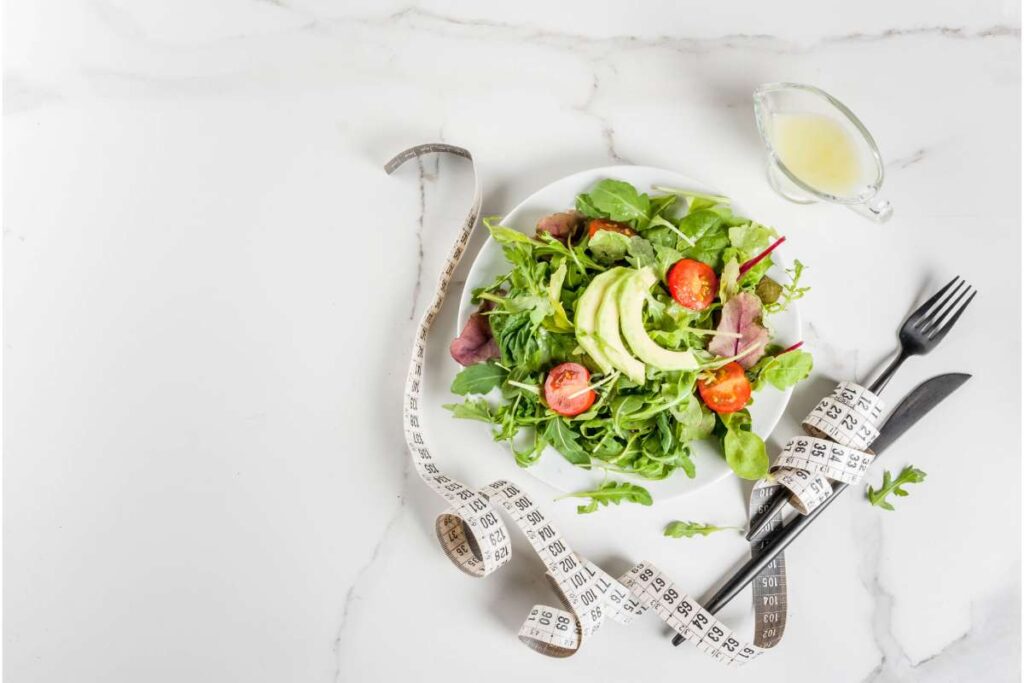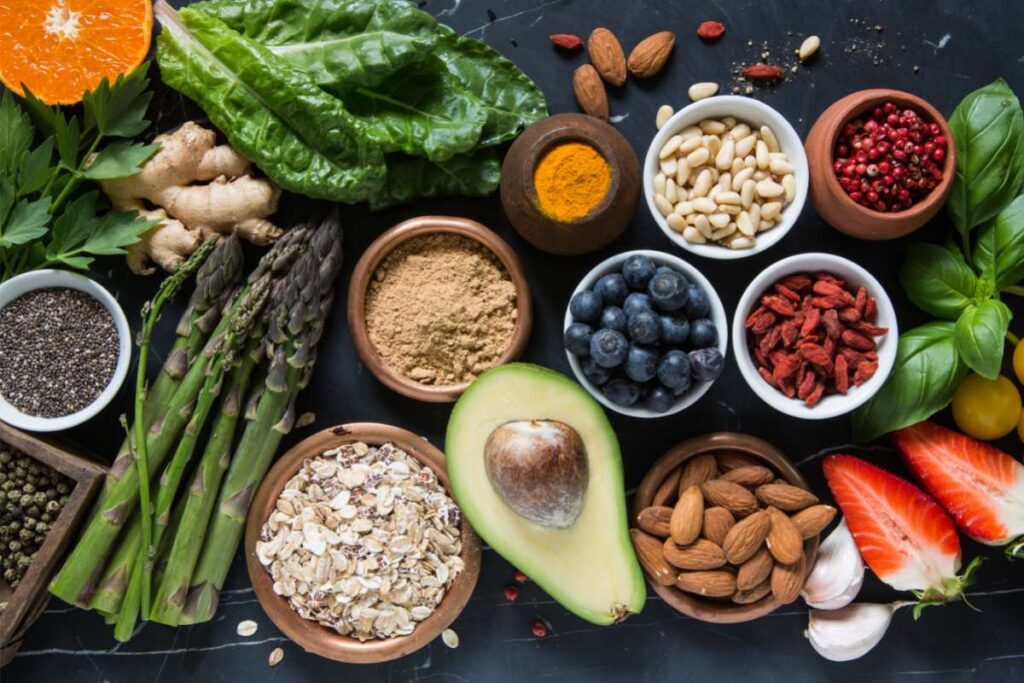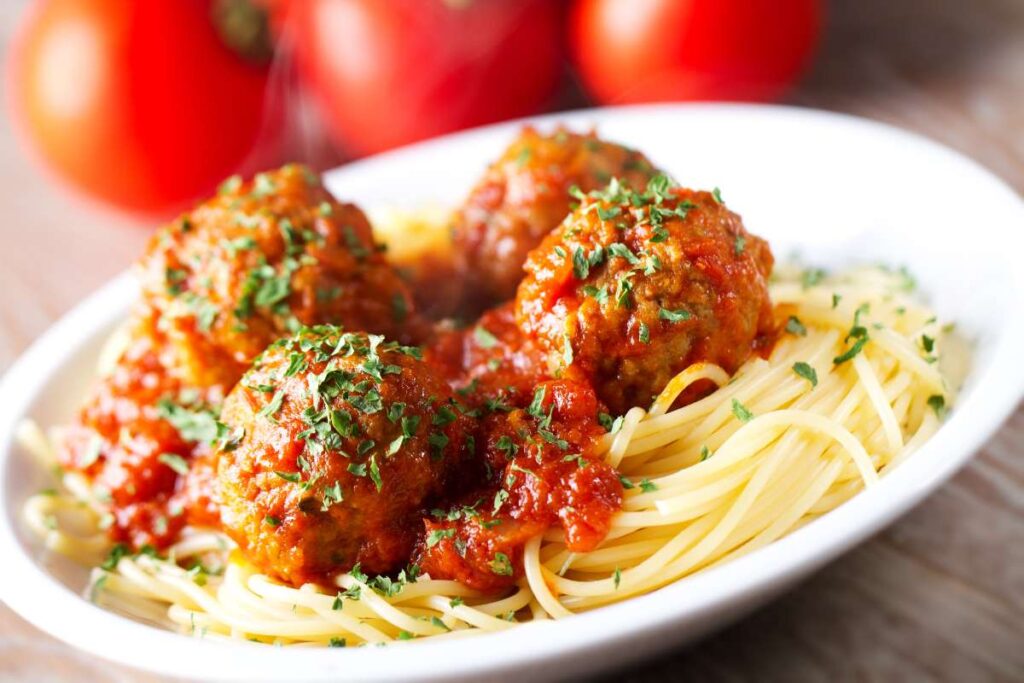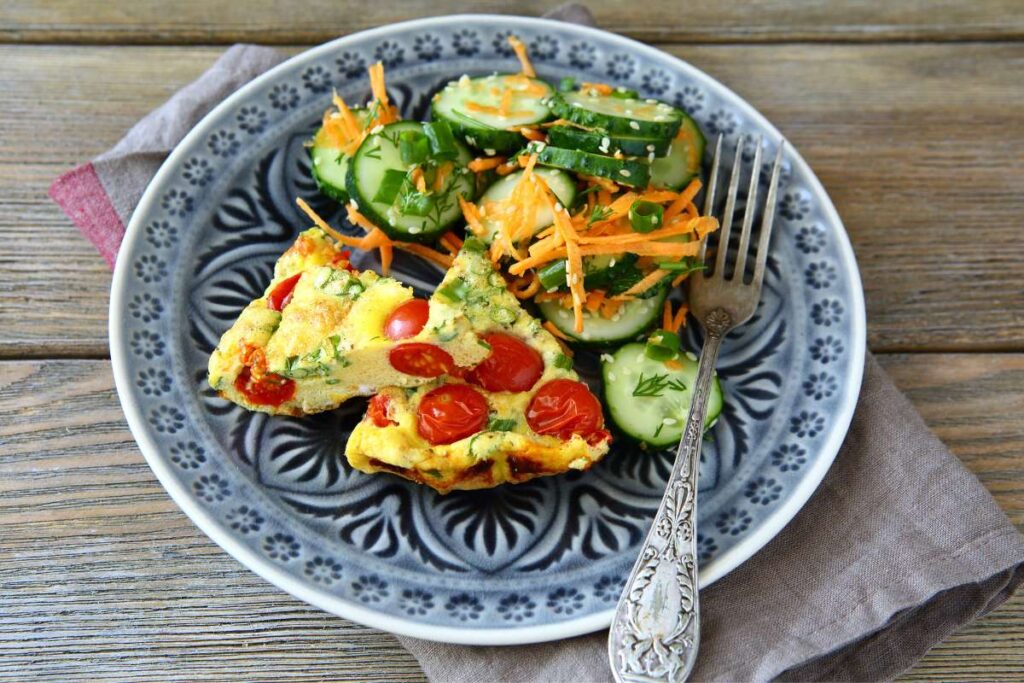This post may contain affiliate links at no additional cost to you. As an Amazon Associate I earn from qualifying purchases. Click to view our full disclosure.
What's inside
One of the most popular diets out right now is the 80/20 rule diet.
What is it? On the 80/20 diet, you eat 80% of foods from natural sources, while 20% can come from processed foods.
That sounds good, but from a registered dietitian’s standpoint, does it work?
The 80/20 rule diet can allow people to leave behind restrictive diets that don’t work long-term. You can include some of the more processed dishes you like as long as at least 80% of your meals are healthy and nutritious foods.
While this seems simple, there are some benefits and drawbacks to following this type of eating.
Keep reading to learn everything about the 80/20 diet. From there, I’ll share a dietitian-approved 7-day meal plan to help you get started.
What is the 80/20 Rule Diet?
Related: What Is The Vertical Diet
The 80/20 rule diet is a guide where you eat 80% of the foods from healthy and nutritious foods, while 20% can come from processed foods.
For many, this is a less restrictive weight loss and management approach. It can lead to sustainable results instead of working for only a couple of weeks.
Who is the 80/20 Rule Diet for?
Related: What Is The Magical Leek Soup Diet?
Anyone can follow the 80/20 diet. Since it doesn’t have any restrictions, people who follow a keto, vegan, or any other eating plan can follow it.
It’s also ideal for those who need a little release once in a while to stay on track and not lose focus.
Plus, if counting calories or macros is not for you, this is a simpler approach to help you reach your goals. Whether it is weight loss or maintenance, the 80/20 diet allows you to eat according to your needs.
Things to Consider Before Deciding on the 80/20 Rule Diet
Related: 10 Simple Tricks To Eating Less Food
Everything from the 80/20 rule sounds incredible.
However, there are some things you need to consider before trying this diet.
What are your treats?

Around 20% should be from processed or “indulgent” foods. Make a list of what those foods are for you.
While there might be a common set list, there might be changes according to your beliefs and preferences.
For example, while some people might think of a burger as part of this 20%, making a burger at home with lean beef, whole grain bread, and vegetables could be part of the 80%.
How to Divide the 80/20
Since there are no strict rules for the 80/20 diet, you can modify it to your liking.
This means you first need to decide how you’ll distribute those 20% foods. It might mean you have one treat per day, or it can mean having a couple of treats during the weekend.
No matter which option you choose, figure out how to spread it throughout the week to prevent eating more than 20%.
Calorie Counting
Finally, another thing you need to consider is the structure.
The 80/20 rule diet is not strict. If you know you need calorie restrictions or certain macros, the 80/20 rule never addresses this.
If you don’t want to count calories, then the 80/20 rule is actually ideal for you.
Does the 80/20 Rule Diet really work?
Related: Does apple cider vinegar break a fast?
Yes, the 80/20 diet works.
In my experience as a registered dietitian, when you restrict and forbid foods, those are the ones that clients want the most. This can lead to binge episodes where they go completely off-plan.
The 80/20 rule creates a balance of foods that can nurture the body but also gives you foods that can nurture the mind and the emotional part of eating.
When you allow yourself to have some indulgences throughout the week but are mostly focused on whole foods, it can enable you to reach or maintain your goals.
The Benefits and Drawbacks of the 80/20 Rule Diet
Related: Metabolic Confusion Diet
There are several benefits and drawbacks to following the 80/20 diet rule.
Let’s take a closer look at each one.
Benefits
No Counting
One of the biggest benefits of the 80/20 rule is that you don’t need to count calories or track macros. While calorie counting might work for some people, if you are like me, this can create more stress and prevent you from enjoying food.
Remember that there are no strict rules, so if you want to count calories you can! But it’s not the point of the diet.
No Restrictions

Another benefit is that it doesn’t forbid foods.
Including those “forbidden” foods takes away their power. So, instead of thinking about it all day or week, you know you can have it any time you want – in moderation.
It’s the forbidden fruit effect. You want what you cannot have.
Sustainable Results
Since 80% of the diet focuses on healthy foods like whole grains, fruits, and vegetables, it promotes a healthy lifestyle.
So, when you include only 20% of the foods from processed foods, it can balance everything out (as long as you eat in moderation).
Easily Adaptable
Finally, due to the 80/20 rule not having any strict rules, you can apply it to any lifestyle.
You can mix it if you have keto, vegan, vegetarian, or other eating plans. In the end, anyone can follow this diet.
Drawbacks
Easy to Overeat
When there is no calorie counting there is less awareness, especially if you are new to portion control.
In my experience, most people tend to underestimate what they eat. This means that even though you think you are having a small portion, you might be having more than you should for your weight, height, age, activity levels, and goals.
Even though you can add those treats you want, you still must practice moderation.
Might Produce Eating Disorders
Classifying food as “good” or “bad” can cause problems, especially for those dealing with eating disorders.
Remember that no one food is good or bad. It’s a matter of how much and how often you add treats that are low in nutrients and high in calories.
The Pros and Cons of the 80/20 Rule Diet
Related: Is Pizza Good For Bulking?
We have talked about the benefits and drawbacks. Let’s summarize the pros and cons of following the 80/20 diet.
Pros
- No calorie counting.
- No food restrictions.
- Promotes sustainable results.
- Can apply to any eating pattern.
Cons
- No counting or portion restriction can cause overeating.
- Can create an unhealthy relationship with food.
What foods should you eat and avoid on the 80/20 Rule Diet?
Related: Intermittent Fasting For Beginners
Technically, you can eat anything you like on the 80/20 rule diet. After all, that is one of the advantages of this type of eating.
Therefore, when talking about what foods to eat, focus on those that make up 80% of the diet. These highly nutritious foods don’t have any processing (or at least it’s minimal).
On the other hand, you should avoid representing the 20% of processed or highly processed foods you need to consume in moderation. These are those “treats” you decided upon when you began.
Remember that everyone can have their take on the 80/20 rule diet. For that reason, there might be some foods you consider to be in a different category.
Foods to Eat

Focus on foods that don’t have a lot of processing. These foods have a lot of vitamins, minerals, and macronutrients. They help nourish the body.
Some examples of foods to eat are:
- Whole Grains: Brown rice, oatmeal, quinoa, whole grain bread, and pasta.
- Legumes: Beans, lentils, chickpeas, and edamame.
- Fruits: Berries, apples, pears, lemon, lime, pineapple, cantaloupe, grapes, bananas, and other fruit.
- Vegetables: Leafy greens, mushrooms, eggplant, garlic, onion, bell peppers, zucchini, carrots, tomatoes, and other non-starchy vegetables.
- Starchy Vegetables: Potatoes, sweet potatoes, and yams.
- Protein: Eggs, chicken, low-fat dairy, fish, seafood, pork, meat, and venison.
- Fats: Olives, avocado, nuts, seeds, and olive oil.
Foods to Avoid
As mentioned before, there are no foods that you have to avoid on the 80/20 rule. However, you do need to consume them in moderation and avoid binging them.
Here is a list of foods you need to eat in moderation. However, these are open interpretations and personal choices.
- Sweets: Candy, sugar, honey, chocolate, and syrups.
- Refined Grains: White rice, white bread, pastries, cookies, and desserts.
- Processed Meats and Cheeses: High-fat cheese, deli meat, and sausages.
- Fats: Butter, sour cream, cream cheese, and mayonnaise.
- Canned Foods: Canned fruit and vegetables.
- Alcohol
How does the 80/20 Rule Diet work?
While we’ve said that the 80/20 rule diet is a “diet,” I like to think it’s more of a philosophy.
You can choose which foods and when to have those things you consider “treats.” Eating this way can promote a healthy balance and add higher-calorie foods (like cookies and pastries) in moderation.
You can also choose when to have those meals. As a tip, make sure you plan out the week to know when you will have those treats and what you will have.
While you can have a treat out of the blue, it is best when you plan your meals to avoid adding too many treats that can result in weight gain.
So, for example, having five meals per day means you have two options.
- Add one treat during the day or one meal that contains processed foods.
- Five meals per day mean having 35 meals for the week. So, you can have seven meals throughout the week from processed foods.
Any option you choose, remember that this is not a free pass to eat in excess amounts. Make sure to listen to your body and eat until you are at 70-80% of your capacity. That means you could have more, but risk feeling too stuffed and unable to breathe.
7-Day 80/20 Rule Diet Plan

There are endless options for you to follow the 80/20 rule diet plan. It depends on your likes and dislikes.
Below, you can find seven days of meals for the 80/20 diet plan. Remember that you can make changes according to your favorite foods, the size of your portions, or when you want to include a treat during the week.
This meal plan includes a treat or a processed meal per day.
Day 1
- Breakfast: Egg muffin cups with tomatoes, mushrooms, and broccoli. Slice of avocado on whole-grain toast.
- Lunch: Brown rice with baked salmon and green salad.
- Dinner: Baked sweet potato with chicken and mushroom sauce and grilled zucchini. Ice cream with chocolate chip cookies for dessert.
- Snacks: Apple with natural peanut butter.
Day 2
- Breakfast: Oatmeal bowl with Greek yogurt, berries, and almonds.
- Lunch: Whole-grain pasta with meatballs and natural (no added sugar) tomato sauce.
- Dinner: Mediterranean salad (lettuce, chickpeas, feta cheese, olives, olive oil, balsamic vinegar, and chicken).
- Snacks: Cookies with milk.
Day 3
- Breakfast: Pancakes with scrambled eggs and bacon.
- Lunch: Quinoa bowl (quinoa, chicken, chopped tomato, shredded carrots, and Asian-style dressing).
- Dinner: Berry salad (kale, strawberries, blueberries, pecans, red onion, feta cheese, chicken, and strawberry dressing).
- Snacks: Cottage cheese with vegetable sticks.
Day 4
- Breakfast: Scrambled eggs with pesto sauce and whole-grain toast.
- Lunch: Caesar salad with homemade dressing.
- Dinner: Chicken curry with lentils and a green salad.
- Snack: A slice of cake with coffee.
Day 5

- Breakfast: Tomato and mushroom frittata with slices of sweet potato toast.
- Lunch: Poke bowl (brown rice, salmon, sesame seed oil, soy sauce, carrots, cherry tomato, and edamame).
- Dinner: Takeout food.
- Snack: Chia seed pudding with walnuts and blueberries.
Day 6
- Breakfast: Hard-boiled eggs on salmon avocado toast.
- Lunch: Cheeseburger with a side salad.
- Dinner: Sweet potato chips with homemade air-fried chicken and green salad.
- Snack: Homemade guacamole with celery sticks.
Day 7
- Breakfast: Breakfast burrito.
- Lunch: Steak with mini potatoes and grilled asparagus.
- Dinner: Grilled lemon chicken with roasted tomatoes.
- Snack: Zucchini chips with hummus.
Conclusion
Related: Are Green Powders A Waste Of Money?
The 80/20 diet is an excellent approach to healthy eating.
It encourages you to eat most of your foods from natural and nutritious sources, all while still including treats and those foods commonly “forbidden.”
It promotes sustainable results either for weight loss or maintenance. You can also adapt the 80/20 diet into any eating style you follow.
Everyone can follow the 80/20 rule diet, whether plant-based, keto, or carb-based.
With that said, whenever you include those treats, you still need to eat in moderation and pay close attention to your eating and hunger levels.
So, is the 80/20 rule diet healthy?
Yes, in fact, it is the type of philosophy I have in my everyday eating.
Comment down below if you’ve tried this diet.
Frequently Asked Questions
What is the 80/20 rule of fitness?
The 80/20 rule means that 80% of your options come from healthy and nutritious foods, while 20% come from processed foods. It allows you to have some wiggle room to add those things you love (like cakes, cookies, and sweets) without affecting your goals.
Is an 80/20 rule diet good for you?
Yes, the 80/20 rule diet allows you to have some treats and prevents you from falling off the plan. In other words, it gives you a more sustainable solution to your goals.
However, you still need to be careful with the portion sizes to prevent overeating or binging.
Is an 80/20 rule diet a healthy diet?
Yes, the 80/20 rule is a healthy diet since 80% of the foods come from minimally processed and highly nutritious foods. It is also a mentally healthy diet. It prevents any restrictions and allows you to have a more peaceful approach.
What does the 80/20 diet look like?
It depends on what allows that 20% to represent. It might mean adding one treat or processed meal in the day (one out of five meals) or adding a couple of meals throughout the weekend.
One of the advantages is that you can adjust it based on your lifestyle.

